
International Research Journal of Engineering and Technology (IRJET) e-ISSN: 2395-0056
Volume: 11 Issue: 12 | Dec 2024 www.irjet.net p-ISSN: 2395-0072


International Research Journal of Engineering and Technology (IRJET) e-ISSN: 2395-0056
Volume: 11 Issue: 12 | Dec 2024 www.irjet.net p-ISSN: 2395-0072
Shubham N. Vairale 1, Amit S. Gawande 2, Dr. Satish K. Deshmukh 3
1Post Graduate Student, Structural Engineering, College of Engineering & Technology, Akola, Maharashtra, India
2,3 Professor, Department of Civil Engineering, College of Engineering & Technology, Akola, Maharashtra, India
Abstract - In many foreign countries, interlocking brick masonry is rapidly becoming a preferred alternative to traditional bricks for environmentally friendly buildings. The researchers have always challenged to make interlocking brick light weight, low cost and improve the performance againstaggressiveenvironment. Anexperimentaleffortmade in this concern. The experimental study gives the results of light weight interlocking brick based on mixed material variation for Dimension, Weight Test, Water Absorption Test, Compressive Strength Test and Density testing were carried outandthetestresultiscomparedwithstandard interlocking brick specimen which were subjected to prior research in the laboratory by using varying percentage of fly ash, stone dust with different mix proportion. In comparison of standard interlocking bricks specimen with light weight interlocking bricks has some advantages such as high compressive strength,lessdensity,durabilityandlowcost.Itiseco-friendly. After the several researches project involving the strengthening and reducing the weight of interlocking bricks by using fly ash in the interlocking bricks. Then the test has shown improvementsinstrength,density,durabilitycompared to standard interlocking brick specimen and Light weight interlocking bricks. The benefit of using fly ash is used to reduce the weight of interlocking bricks. The brick is moulded with dimension of (300 x 150 x 125mm) with curing continuously for 28 days. Then the brick was finally tested using a compression testing machine. The fly ash ash gives more compressive strength, less density and durability as compared to the standard interlocking brick specimen.
Key Words: Interlocking Bricks, Fly Ash, Compressive Strength, Water Absorption, Density.
AsperG202024reportIndiahasemergedasthefastest developingmajoreconomywithintheworld.Andtogether withthatIndia'spopulaceisdevelopingquicklyandisright now the foremost populated nation within the world. For India'sdevelopingeconomyandpopulacerequeststoboost the public infrastructure speculation, an rise in family venture in genuine bequest and development industry.
A wide variety of materials are utilized within the developmentindustry.Whenconsideringtheirapplicationin
divider components, customary burnt clay bricks are the foremostbasicbuildingmaterialsforhousesdevelopment. Be that as it may, the quick development in today's developmentindustryhasobligedthegraciousengineersin lookingforamodernbuildingtechniquethatwillresultin indeedmorenoteworthyeconomy,moreeffectiveandsolid asanelectivefortheordinarybrick.Inatropicalnationlike India the burnt clay brick is the foremost fundamental buildingfabricfordevelopmentofhouses.Itisdetailedthat theprerequisiteofbricksfordevelopmentmovementsums tobemorethan140billionnumbersyearly.
1.1 The aim of study
To do experimental study of light weight interlocking brickbasedonmixedmaterialvariationdesign.
1.2 The objective of study
1. To produce light weight interlocking brick. 2. To determine optimum compressive strength of light weight interlockingbrick.3.Todeterminewaterabsorptionoflight weightinterlocking brick. 4. To determine density oflight weightinterlockingbrick.
1.3 The scope of study
Theproposedinterlockinglightweightbricksallowsfora quick and cost effective construction. It’s over comes the conventional clay bricks, whichcouldn't bearthe stressas they cannot transfer the seismic load across the structure equivalently. And act as a good earthquake resistance structure.It’sallowedexposedbrickwallconstructionand gives good aesthetic view, improved constructability, performance and cost as well resulting to alternative for sustainableconstructionindustry.
2.1Introduction of Methodology
Thefirststepinstudyingistoscheduleyourstudytime.The activitieswereplanningduetotimerequiredtomakesure theproductwillbecompletedinscheduletime.Thepointof thetechniqueinquireaboutistoattainthedestinationsof considerasexpressedinthischapter.

International Research Journal of Engineering and Technology (IRJET) e-ISSN: 2395-0056
Volume: 11 Issue: 12 | Dec 2024 www.irjet.net p-ISSN: 2395-0072
In our study, weused three basic materials in order to producethelightweightinterlockingbrickthatareOrdinary Portlandcement(OPC),flyash,fineaggregate(dust).These materialswerefundamentallycharacterizedincompliance withIndianstandards.Allmaterialsareavailablelocallyin Maharashtra.
2.2.1Cement
Cementisamaterialusedinconstructionthat bindsothermaterialstogetherbysetting,hardening, andadheringtothem.OrdinaryPortlandcementof53 grade were used satisfying all the IS: 12269-1987 requirementswasusedinmakingthebricks.
Oneoftheindustrialwastesisflyash,fine-grainedgray producedbyburningcoal,whichisrecoveredfromthefinal combustionofcoal.Inthisstudy,ClassFyashwasused,and it contains low content of CaO and exhibit pozzolanic propertiesandhavingspecificgravityofflyashis2.76was used.TheflyashwascollectedindrystatefromtheParas Thermalpowerstation.
2.2.3Stone
Thefinestkindofcrushedstoneiscalledstonedust,or stone screens. Stone dust creates a hard, water-resistant surfacewhenappliedalone.Whenusedwithalargerstoneit actsasabindingagentbecauseofitsabilitytoformastrong, nonporoussurface.Powderformstonedustavailablelocally usedinmoderatequantityforpreparingthebricks.Itssmall size allows the bricks to maintain their correct form, especiallythecornersandedges.
2.2.3Water
PlaneOrdinarytapwaterwasusedforbothmixingthe constituentsofthebricksaswellasforthecuringofbricks. Waterrequirementsdependonthefollowingfactors:
•Production–waterconsumptiondependsonwater-tocementratios
• Curing – depends on duration in days (minimum 7days). The potential strength of any Ordinary Portland Cement (OPC) product will be maximized by curing under moist conditions. The highest rate of reaction (hydration) betweencementandwatertakesplaceinthefirstthreeto sevendays,whichthereforerequirepropercuring/attention (BS5328-1:1997andBS56283:2005).
The second steps in our project methodology, we used Hydraformshapewhichisthesimplesttypeofinterlocking brickseeinfig.1inshape,wheninterlockedmakesatongue andgroovedjointatthesidesandtopandbottom.Beingfree toslidealongthecoursehorizontally,itcanbepushedalong to achieve tighter perpends (vertical joints) see in fig. 2 Hydraformbrickismouldedbypressingalongitslengthfrom theends.Itisalsoasolidbrick,Thelength,widerandthicker oftheinterlockingbrickinsizeof(300x150x125mm).The stabilityofthewall builtfromtheHydraformbricksisnot provided by the locking mechanism but by the width and weight(massiveness)ofthebrick.Moreoverthecompression must be sufficient to allow a fresh brick to withstand the squeezingforcesoccurringwhenitismanuallymovedfrom machinetothecuringarea.
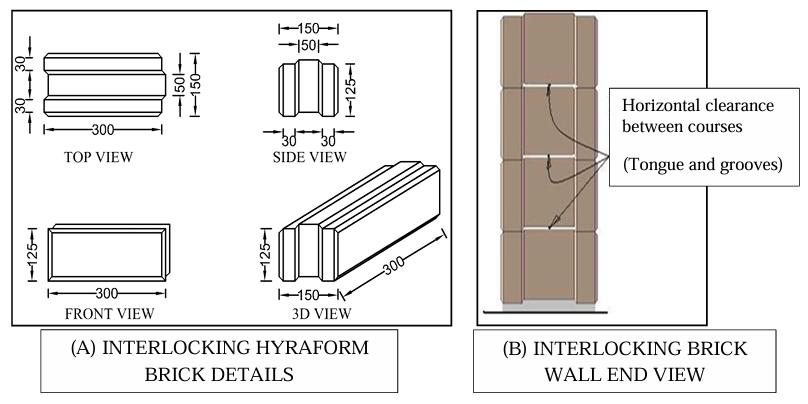
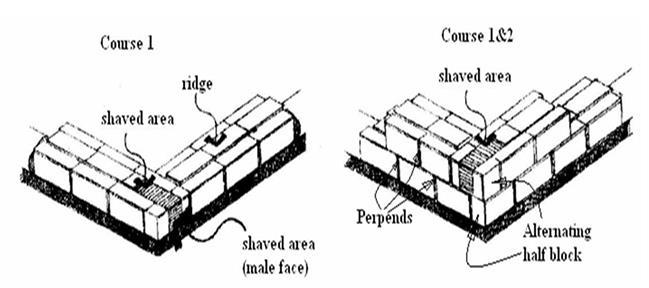
Inthisexperimentalstudytwostandardspecimenasper IS2250:1981wassuitablydesignedforM5grade,M3grade ofmortarandfoursamplemixdesignwereusedtoidentify theoptimummixdesignforLightweightinterlockingbrick. Themixdesignwasdonebasedontheproportionofvarious

International Research Journal of Engineering and Technology (IRJET) e-ISSN: 2395-0056
Volume: 11 Issue: 12 | Dec 2024 www.irjet.net p-ISSN: 2395-0072
materials like cement, fly ash and stone dust. The first standard specimen sample mix design for (1:6) contains 16.67% of cement and 83.33% of stone dust. This type of interlocking brick is named as S1. The second standard specimen sample mix design for (1:8) contains 12.50% of cement,87.50%ofstonedust.Thistypeofinterlockingbrick isnamedasS2.Thestandardspecimenmixdesignisgivenin Tableno.1
Table -1:StandardInterlockingbrickMixDesigns
Sample
Thefirstsamplemixdesignfor(1:3:4)contains12.50%of cement,37.50%offlyashand50%ofstonedust.Thistypeof interlocking brick is named asA1. Thesecondsample mix designfor(1:3.4:3.6)contains12.50%ofcement,42.50%of flyashand45%ofstonedust.Thistypeofinterlockingbrick isnamedasA2.Thethirdsamplemixdesignfor(1:3.8:3.2) contains 12.50% of cement,47.50% of fly ashand 40% of stone dust. This type of interlocking brick is named asA3. Andfourthsamplemixdesignfor(1:4.2:2.8)contains12.50% ofcement,52.50%offlyashand35%ofstonedust.Thistype ofinterlockingbrickisnamedasA4.Thesamplemixdesignis giveninTableno.2
Designation
2.5 Casting of Light Weight Interlocking Brick Specimen
Afterthecollectionandproportionofmaterialscasting processiscarriedout.Forcastingoflightweightinterlocking brickthecement,flyashandstonedustwereusedinvarying mix proportions given in table no. 4 and table no. 5. The materials are proportioned by the weight batching. A pan mixerandhydraulicmachineusedforcastingthebrickssee infig.3.Themixerwasthoroughlycleanedbeforethebricks werecast.Toachievetherequiredworkability,drycement and stone dust were added, well mixed, and then clean drinkingwaterwasadded.Followingthepouringofthebrick mix in a hydraulic machine, the bricks were removed and placedonaflatplatformbeneaththeshedtodry.Theblocks have geometric size of 300mmx150mmx125mm .This
machineproducessolidblocksoflateritecompositionmainly andstabilizedwithcementmaterial.
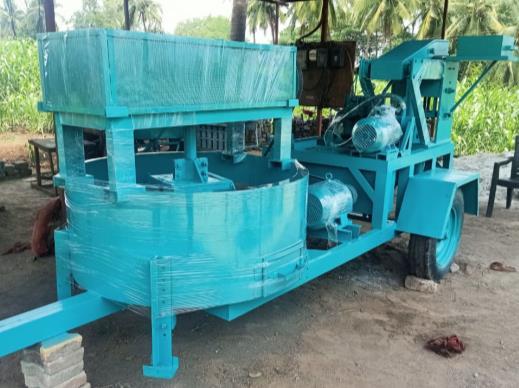
2.6
Hardening of any concrete products requires the continuedpresenceofwaterinthebricktoenablecementto complete hydration process. After casting the bricks are allowedforsurfacedryfor24hoursindirectsunlight.Then cured normally for 28 days by spraying water four to five timesinonedayseeinfig.4
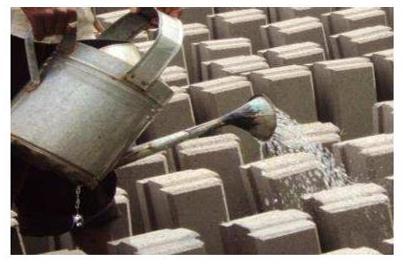
Thecastedinterlockingbricksweretakenoutfromwater onedaypriortothetestingandweretestedforcompressive strengthafter28days.
3.1Dimensions Test
The dimensions of the interlocking brick specimens measuredbyanVernierCaliperonday28seeinfig.5.Asper IS:1077:1992,toleranceforbrickwhenmeasured20bricks byarrangingonebesideanotherforlength,widthandheight separatelyis(40mm)theresultofbricksdimensionstest. The brick passes the dimension test if its dimensions are withintolerance;ifnot,itfails.

International Research Journal of Engineering and Technology (IRJET) e-ISSN: 2395-0056
Volume: 11 Issue: 12 | Dec 2024 www.irjet.net p-ISSN: 2395-0072
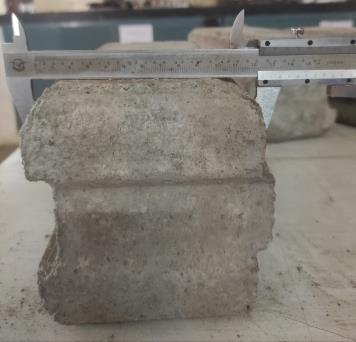
Weightofdifferentproportionsofinterlockingbricksis measuredwiththehelpofdigitalweighingbalancemachine seeinfig.
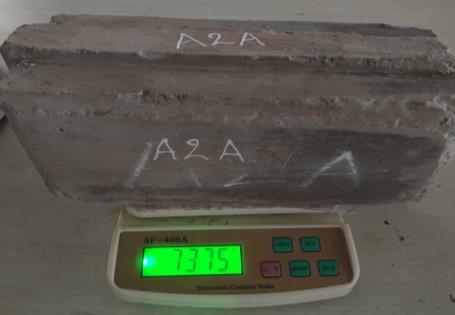
Thebricks,whentestedinaccordancewiththeprocedure laiddowninIS3495(Part2):1992afterimmersionincold waterfor24hours,waterabsorptionshallnotbemorethan 20 percent by weight up to class 12.5 and 15 percent by weight for higher classes. The test specimens shall be completelyimmersedinwateratroom-temperaturefor24h. Thespecimensshallthenbeweighed,whilesuspendedbya metalwireandcompletelysubmergedinwater.Theyshallbe removed from the water and allowed to drain for three minutebyplacingthemona10mmorcoarserwiremesh, visiblesurfacewaterbeingremovedwithadampclothand immediately weighed (W2). Subsequent to saturation, all specimens shall be dried in a ventilated oven machine at 100‖Cto115°Cfornotlessthan24hseeinfig.7andcoolthe bricks to room temperature and weight (W1). Formula to calculate water absorbed by the bricks, using following formula.
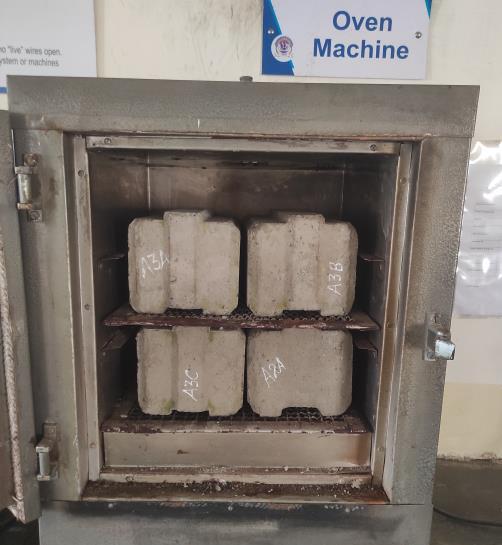
The specimen is then placed between plates of compression testing machine see in fig.8. Load is applied axiallyatuniformratetill failure.Maximumloadatfailure divided by average area of bed face gives us compressive strength.
Compressive strength in N/mm2 =

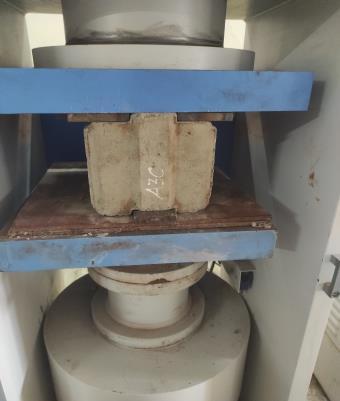
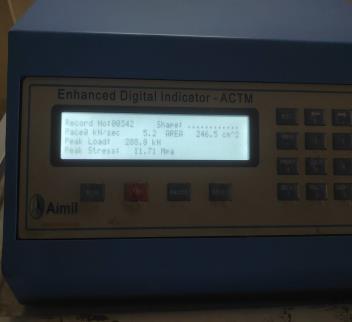

Waterabsorptionin%byweight=( )x100
Threebrickstakenatrandomfromthesamplesshallbe driedtoconstantmassinasuitableovenheatedto100Cto findtheMassofbrick,inkgapproximately.Aftercoolingthe bricks to room temperature, the dimensions of each brick shallbemeasuredinmeter(tothenearestmillimeter)and theoverallvolumecomputedincubicmeters.Thebrickshall thenbeweighedinkilogramsandthedensityofeachbrickis calculated.

International Research Journal of Engineering and Technology (IRJET) e-ISSN: 2395-0056
Volume: 11 Issue: 12 | Dec 2024 www.irjet.net p-ISSN: 2395-0072

Differenttestswereconductedtostudythebehaviorof interlocking brick and standard brick. This covers the behaviorofspecimenundereachtest.
4.1 Dimensions Test
Thedimensionsoftheeachinterlockingbrickspecimens aremeasuredtothenearestmillimeterbyanVernierCaliper onday28.
4.2 Weight Test
Weightofinterlockingbricksaremeasuredtothenearest gramandmaybevariedbasedonthedifferentproportionsof flyashandstonedust
4.3 Water Absorption Test
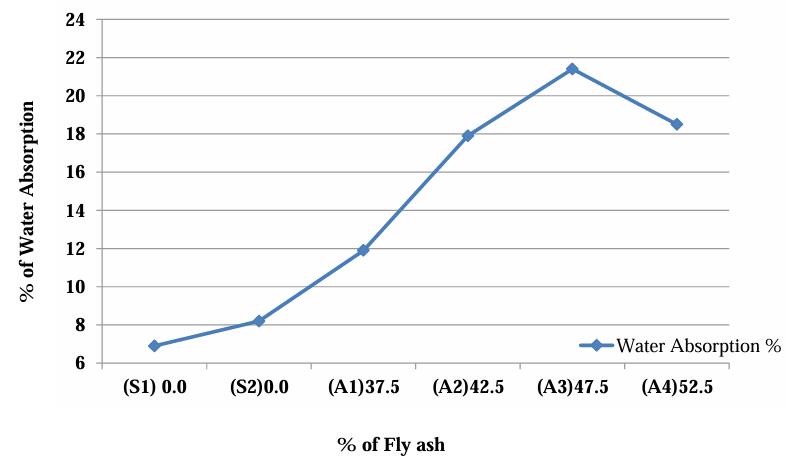
Graph -1:%ofWaterAbsorptionv/s%ofFlyash
It is observed in the graph shown in graph 1 the water absorption of bricks increases with the increase in fly ash content replacing stone dust. Among the four samples of interlockingbrickA1,A2,A3andA4Comparedwithstandard brickA1samplemixdesignbricksabsorb11.9%ofwater only; it has less water absorption property. The average waterabsorptionofA1sampleofinterlockingblocksisfound tobe11.9%,whichissatisfiedasperIS:3495(PartII)–1992 whichspecifiesthebricksshouldnotabsorbmorethan20% ofwaterandclassifiedas1stclassbricks
4.4 Compressive Strength Test
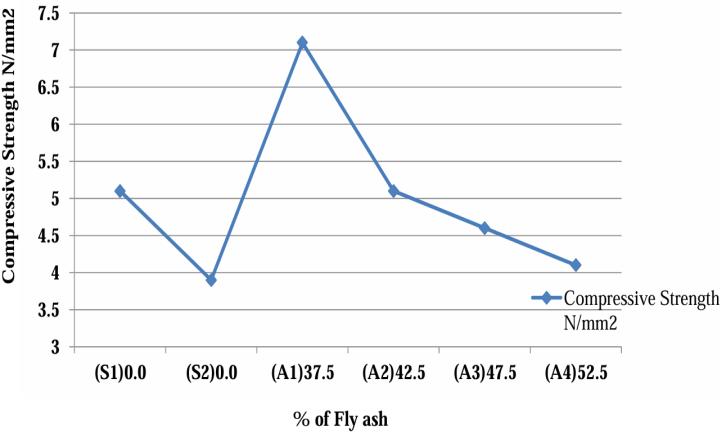
Graph -2 CompressiveStrengthN/mm2v/s%ofFlyash
Thegraphofaveragecompressivestrengthofinterlocking brickshowningraph2decreaseswiththeincreaseinflyash content replacing stone dust from 37.5 % to 47.5%. The averagecompressivestrengthofA1sampleofinterlocking brickisfoundtobe7.1MPa,whichissatisfiedtheminimum averagecompressivestrengthofstandardsampleS1istobe 5.1MPa.Theaveragecompressivestrengthofinterlocking brick A1 sample which is 7.1 MPa which is found to be greaterthanthecompressivestrengthofstandardbricksS1 whichis5.1MPa.
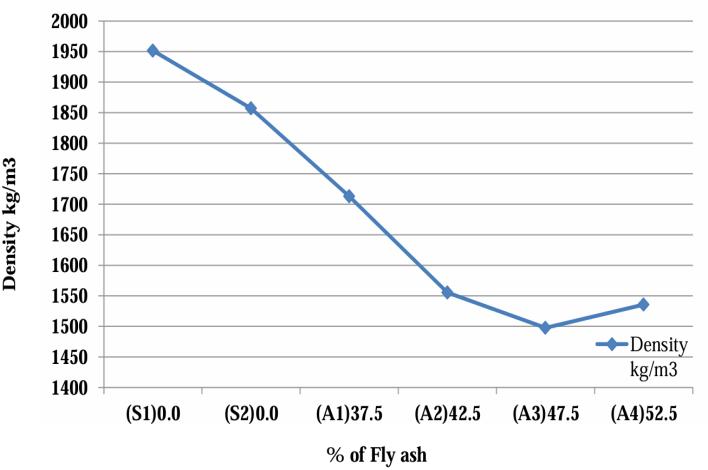
Graph -3 Densitykg/m3v/s%ofFlyash
Itisobservedthatthewaterabsorptionanddensityare closely related to each other. As the water absorption of interlockingbrickincreaseswiththedensityofinterlocking brickdecreases.Thegraphofaveragedensityofinterlocking brickshowningraph3decreaseswiththeincreaseinflyash content replacing stone dust. The average density of interlockingbrickA3sampleis1497.5kg/m3whichisfound tobelesserthanthecompressivestrengthofstandardbricks S1whichis1951.4kg/m3.Thedensityofinterlockingbricks

International Research Journal of Engineering and Technology (IRJET) e-ISSN: 2395-0056
Volume: 11 Issue: 12 | Dec 2024 www.irjet.net p-ISSN: 2395-0072
wasfoundtobe23percentlesserthanthatofthestandard bricks.
Based on the experimental investigation reported in this study,followingconclusionsaredrawn:
1)The dimensional test is conducted on light weight interlocking bricks and standard interlocking bricks. The dimensional errors are found to be relatively small and undertoleranceininterlockingbricksasperIS-1077(1992).
2)Thewaterabsorptionoflightweightinterlockingbricks increases with the increased in % of fly ash content as comparedtostandardinterlockingbricksbutreplacementof flyashabove47.5%,waterabsorptiondecreases.
3) The average compressive strength of light weight interlockingbricksdeceaseswiththeincreasedin%offly ashcontentascomparedtostandardinterlockingbricks.
4)Thedensityoflightweightinterlockingbricksdecreases withtheincreasedin %offlyashcontentascompared to standard interlocking bricks but replacement of fly ash above47.5%,densityofinterlockingbricksincreases.
[1] Mutune Samson Muinde,“An Investigation Into The IssuesInfluencingTheUseofInterlockingStabilisedSoil BlocksInKenya,ACaseStudyofSiayaCounty.Athesis repot, University of Nairobi or any other University,2013.
[2] Fajar Putra Mobiliu, Mursalin, Muhamad Jahja, Dewa Gede Eka Setiawan, Nugraha Oktofelly Dewaputu, FachrulLatief,NancyNovianaLantapon,“Compressive Strength and Water Absorption Capacity on Brick Interlock with Fly Ash Addition,” Computational and Experimental Research in Materials and Renewable Energy(CERiMRE),2023,Volume7,Issue1,pp.64-77.
[3] SantoshBharathy.V,ArunKumar.S,Sanjay.R,S.Karthik Raja,“StrengthCharacterticsComparisionOfFlyashAnd AcaciaAshInterlockingBricks,”InternationalJournalof PureandAppliedMathematics,2018,Volume119No. 152018,pp.1391-1402.
[4] G.Pavithra, R.Priyanka, L.Sahana Sree, V.Sarumathi, U.Sathish, K.S.Sowmiya,“Experimental Analysis of Interlocking Bricks by Using Sewage Sludge And Fly Ash,” SSRG International Journal of Civil Engineering (SSRG-IJCE)–SpecialIssueICETSST-April2018.
[5] FathealiAShilar,S.S.Quadri,“PerformanceEvaluationOf Interlocking Bricks Using Granite Waste Powder,” International Journal of Engineering Applied Sciences
and Technology, 2019 Vol. 4, Issue 2, ISSN No. 24552143,pp82-87.
[6] AminAl-Fakih,BasharS.Mohammed,MohdShahirLiew and Wesam S Alaloul,”Physical Properties of The RubberizedInterlockingMasonryBrick,”International Journal of Civil Engineering and Technology (IJCIET) Volume9,Issue6,June2018,pp.656–664.
[7] R.Sayanthan, S.Ilamaran, Mohamed Rifdy and S.M.A Nanayakkara,”DevelopmentOfInterlockingLightweight Cement Blocks,” Special Session on Construction Materials & Systems, 4th International Conference on StructuralEngineeringandConstructionManagement 2013,Kandy,SriLanka,13th,14th&15thDec.2013.
[8] L.Arunraja,M.Arumugam,K.Malaichamy,“Mechanical Properties Of Light Weight Bricks Using Perlite And Lime Material,” SSRG International Journal of Civil Engineering- (ICRTCETM-2017) - Special Issue - April 2017.
[9] HeyderAhmed,Sugini,“Astudyoninterlockingbrick innovationusingrecycledplasticwastetosupportthe acousticandthermalperformanceofabuilding,”Jurnal TeknikArsitektur,Volume6Issue3,Dec.2021.
[10] S. Kavipriya, K.J. Jegidha, Dr.S.Suresh Babu, “Experimental Study On Light Weight Interlocking Blocks,”International Journal of Engineering and Techniques-Volume7Issue2,March2021.